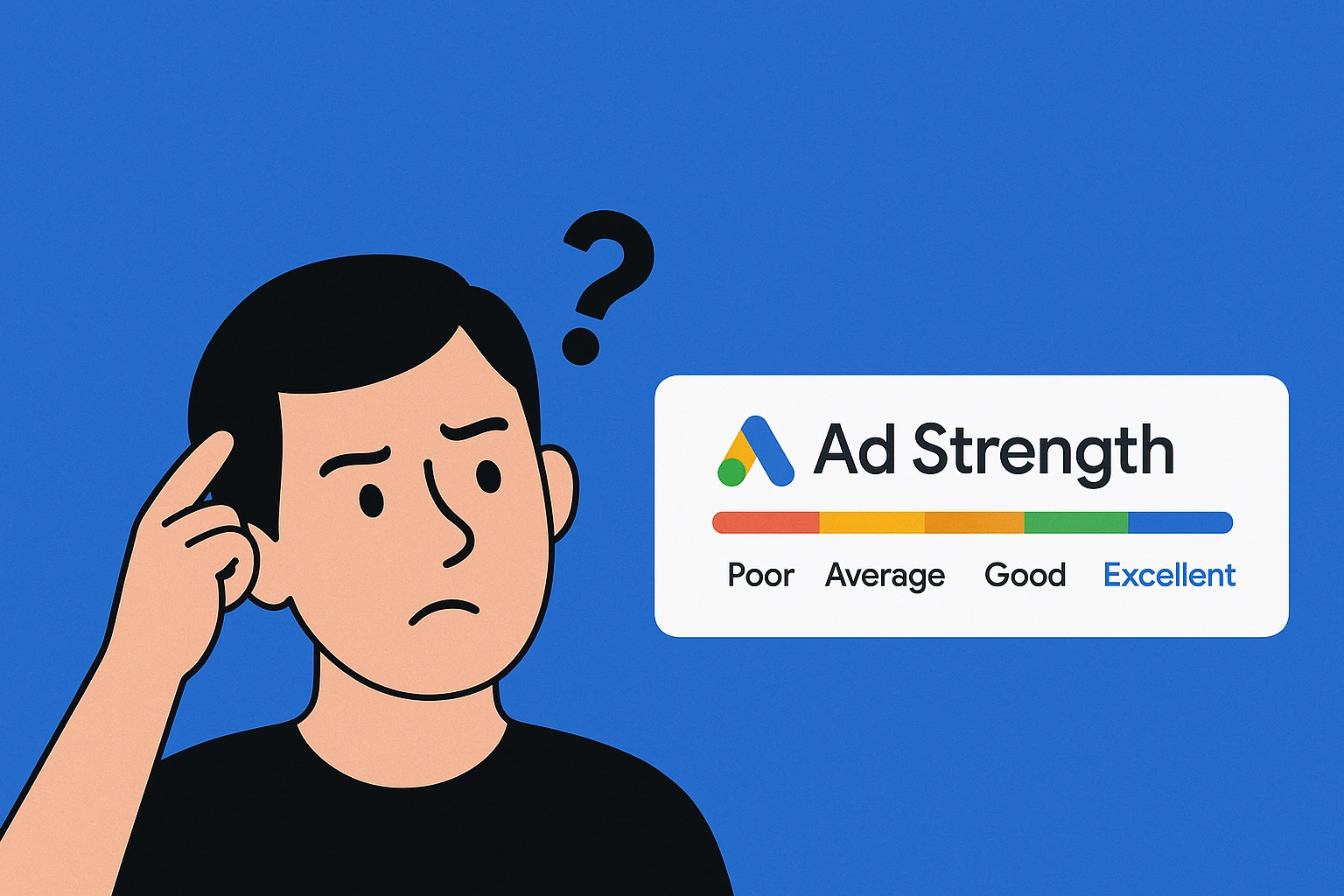Does ad strength matter?
At Adregen, we’ve been running ads since long before ad strength existed.
We optimise ads based on principles that have stood the test of time: relevance, clarity, testing, and performance, not just Google’s opinion of what “good” looks like.
That’s not to say ad strength is completely useless. In fact, it can be helpful, particularly on non-Search campaigns like Performance Max or Demand Gen.
But if you’re judging a responsive search ad purely on ad strength, you’re missing the bigger picture.
In September 2024, Navah Hopkins wrote an excellent blog post breaking down ad strength performance across more than 1 million ads. We’ll link to it at the bottom of this blog post.
We’re sharing what we’ve learned at Adregen, based on real-world campaigns, and how we think advertisers should be using ad strength.
What is ad strength?
Ad strength is Google’s metric that estimates the diversity, relevance, and quality of your responsive search ads. It provides a rating from “Poor” to “Excellent” based on factors like:
- Number of unique headlines and descriptions
- Keyword inclusion
- Use of pinning
- Overall ad variety
The idea is to encourage advertisers to create more flexible, test-friendly ads. And to be fair, that’s not a bad idea.
But here’s the thing…
Ad strength is biased
There are three core areas where it can be nigh on impossible to achieve an “Excellent” score.
1) Campaign structure
Ad strength heavily depends on how your campaign and ad groups are structured.
For example, if you have one ad group with lots of closely related keywords (same intent, different phrasings), you’ll likely get a lower ad strength unless all those variations are repeated in your headlines.
That sounds logical, but in practice, trying to include every keyword creates robotic, repetitive ads, often with 10 near-identical headlines. You sacrifice USPs, emotional hooks, and real persuasive copywriting just to tick a Google box.
Worse still, a single-keyword ad group might score “Excellent”. That’s not because the ad is better, but because there are fewer keywords to match.
Google rewards structure, not strategy, and sometimes the best-performing ads aren’t the ones that get top marks on a scorecard.
2) Large pools of data (and unrealistic testing volume)
Ad strength encourages you to add the maximum 15 headlines and 4 descriptions to every ad, regardless of how much traffic it actually gets.
On paper, this allows Google to mix and match different ad versions (permutations) and optimise performance.
But there’s a massive catch: in order for an individual headline or description to get a performance rating, Google recommends 2,000+ impressions in the top search position in 30 days.
In reality, that could mean closer to 3,000+ impressions per asset.
If you’re running 15 headlines and 4 descriptions, you’ve created up to 32,760 ad permutations.
That could require nearly 100 million impressions in 30 days to properly test every variation.
Here’s a breakdown of what that looks like:
| Headlines | Descriptions | Permutations | Impressions needed |
|---|---|---|---|
| 3 | 2 | 12 | 36,000 |
| 6 | 3 | 1,440 | 2,160,000 |
| 10 | 4 | 8,640 | 25,920,000 |
| 15 | 4 | 32,760 | 98,280,000 |
The takeaway? If your ad group only gets a few thousand impressions a month, adding 15 headlines is counterproductive. You’ll never get proper feedback on which assets work, and you risk keeping your ad in a perpetual “learning” state.
3) Pinning
Google really doesn’t like it when you pin things.
Even a single pinned headline can drop your ad strength from “Excellent” to “Low.”
And while pinning does reduce flexibility and permutations, there are plenty of valid reasons to use it:
- Regulatory or legal copy requirements
- Offer messaging that only makes sense in a specific position
- Branding guidelines that need to be followed
Pinning does limit variation, and that’s fine. You don’t always need 30,000 variations, you need a few good messages shown in the right way.
Just because Google marks you down for it doesn’t mean it’s wrong.
So… should I ignore ad strength?
Not entirely.
Here’s our take:
Larger accounts with significant impression volume should pay more attention to ad strength. Not because it’s perfect, but because they have the data to support asset rotation and testing at scale.
Smaller accounts should prioritise strong, differentiated messaging over volume. Don’t flood Google with 15 headlines you can’t test, but use fewer, better-crafted lines that actually get served (and you can optimise based on what works).
Always optimise for performance, not Google’s checkbox. Use asset reports, impression data, and conversion metrics to inform what works.
The bottom line
Ad strength is a nice-to-have, not a must-follow. It’s a helpful prompt when building your ad, but it’s not the final judge of quality.
Write ads for your users. Let data guide your decisions, and remember: even Google’s machine learning can’t beat good strategy.
Here’s the full Optmyzr study by Navah Hopkins: https://www.optmyzr.com/blog/google-ad-strength-study/
Want help building high-performing ads, regardless of what ad strength says? Talk to us at Adregen.
